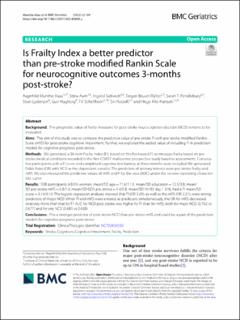| dc.contributor.author | Munthe-Kaas, Ragnhild | |
| dc.contributor.author | Aam, Stina | |
| dc.contributor.author | Saltvedt, Ingvild | |
| dc.contributor.author | Wyller, Torgeir Bruun | |
| dc.contributor.author | Pendlebury, Sarah T. | |
| dc.contributor.author | Lydersen, Stian | |
| dc.contributor.author | Hagberg, Guri | |
| dc.contributor.author | SCHELLHORN, TILL | |
| dc.contributor.author | Rostoft, Siri | |
| dc.contributor.author | Ihle-Hansen, Hege | |
| dc.date.accessioned | 2022-12-09T09:41:29Z | |
| dc.date.available | 2022-12-09T09:41:29Z | |
| dc.date.created | 2022-04-29T13:03:30Z | |
| dc.date.issued | 2022 | |
| dc.identifier.citation | BMC Geriatrics. 2022, 22 (1), . | en_US |
| dc.identifier.issn | 1471-2318 | |
| dc.identifier.uri | https://hdl.handle.net/11250/3036949 | |
| dc.description.abstract | Background
The prognostic value of frailty measures for post-stroke neurocognitive disorder (NCD) remains to be evaluated.
Aims
The aim of this study was to compare the predictive value of pre-stroke FI with pre-stroke modified Rankin Scale (mRS) for post-stroke cognitive impairment. Further, we explored the added value of including FI in prediction models for cognitive prognosis post-stroke.
Methods
We generated a 36-item Frailty Index (FI), based on the Rockwood FI, to measure frailty based on pre-stroke medical conditions recorded in the Nor-COAST multicentre prospective study baseline assessments. Consecutive participants with a FI score and completed cognitive test battery at three months were included. We generated Odds Ratio (OR) with NCD as the dependent variable. The predictors of primary interest were pre-stroke frailty and mRS. We also measured the predictive values of mRS and FI by the area (AUC) under the receiver operating characteristic curve.
Results
598 participants (43.0% women, mean/SD age = 71.6/11.9, mean/SD education = 12.5/3.8, mean/SD pre-stroke mRS = 0.8/1.0, mean/SD GDS pre-stroke = 1.4/0.8, mean/SD NIHSS day 1 3/4), had a FI mean/SD score = 0.14/0.10. The logistic regression analyses showed that FI (OR 3.09), as well as the mRS (OR 2.21), were strong predictors of major NCD. When FI and mRS were entered as predictors simultaneously, the OR for mRS decreased relatively more than that for FI. AUC for NCD post-stroke was higher for FI than for mRS, both for major NCD (0.762 vs 0.677) and for any NCD (0.681 vs 0.638).
Conclusions
FI is a stronger predictor of post-stroke NCD than pre-stroke mRS and could be a part of the prediction models for cognitive prognosis post-stroke. | en_US |
| dc.language.iso | eng | en_US |
| dc.publisher | BMC | en_US |
| dc.rights | Navngivelse 4.0 Internasjonal | * |
| dc.rights.uri | http://creativecommons.org/licenses/by/4.0/deed.no | * |
| dc.title | Is Frailty Index a better predictor than pre-stroke modified Rankin Scale for neurocognitive outcomes 3-months post-stroke? | en_US |
| dc.title.alternative | Is Frailty Index a better predictor than pre-stroke modified Rankin Scale for neurocognitive outcomes 3-months post-stroke? | en_US |
| dc.type | Peer reviewed | en_US |
| dc.type | Journal article | en_US |
| dc.description.version | publishedVersion | en_US |
| dc.source.pagenumber | 0 | en_US |
| dc.source.volume | 22 | en_US |
| dc.source.journal | BMC Geriatrics | en_US |
| dc.source.issue | 1 | en_US |
| dc.identifier.doi | 10.1186/s12877-022-02840-y | |
| dc.identifier.cristin | 2020137 | |
| cristin.ispublished | true | |
| cristin.fulltext | original | |
| cristin.qualitycode | 1 | |

